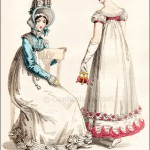La Belle Assemblée, December 1807.
“Morning and Evening Dresses in November 1807.”
In the early days of this magazine (before Mrs. Bell got involved, pushing her own design specifications) the descriptions of the fashion prints often gave alternatives for fabrics, colors, trimmings, etc. Here, for example, “A high military vest of French cambric, lawn, or muslin ” or “Circassian robe-pelisse of pale olive, dove, puce, or purple.” It provides the dressmaker or home seamstress with options, which must have been helpful. Similar options are provided in the General Observations on the Most Approved and Elegant Fashions for the Season, eg “the long conical cloak of crimson, orange, or brown, formed of kerseymere, or Georgian cloth …” Such alternatives appear less frequently in the 1810s and beyond.
The hairdo on the left is given a very detailed description, something more often seen in Gallery of Fashion descriptions of the previous decade, but less often in these later publications. But this is a pretty complicated hairdo.
The print is described in the magazine as follows:
“No. 1–AN EVENING DRESS. A simple gown of white satin, or coloured cloth; triangular front, finished with silver beading. Plain back, brought to a point at the bottom of the waist, which is increased in length. A full short sleeve, with loose slashed ornaments in the Spanish style; the slashes wrought in an elegant patterns of silver embroidery, and severally finished with a small correspondent tassel. The hair bound tight round the head in the Grecian style, twisted in braids behind, the ends formed in a tuft of full curls, and confined with a gold comb, from which are seen pendant ringlets, similar to those that fall on the left shoulder; in front it is divided over the left temple with the Diana crescent, of pink topaz, above which are a few dishevelled curls. Necklace and earrings of pink topaz, bracelets of linked pearl, with correspondent studs. A Circassian scarf of orange or crimson, figured or plain, with rich border and fringe at the ends, of colours tastefully varied. This shawl is thrown carelessly round the throat, or across the shoulders, or is formed in a negligent and graceful drapery, by the disposition of the hands. Turkish slippers of white satin; and white kid gloves rucked.
“Fig. 2–MORNING WALKING DRESS. A high military vest of French cambric, lawn, or muslin, buttoned down the front; and formed with chemisette waist, and high collar. Circassian robe-pelisse, of pale olive, dove, puce, or purple, formed of nap velvet, twill sarsnet, kerseymere, or Georgian cloth; bordered with a rich shaded brocade ribband, embroidery in coloured silks, or trimmings of fancy fur. A beaver hat of the same colour as the coat, turned up on the left side, with cockade and band à-la-militaire, and ornamented with a crimped willow feather. Hair cropped; coral earrings; York tan gloves; and slippers of red Morocco.”








